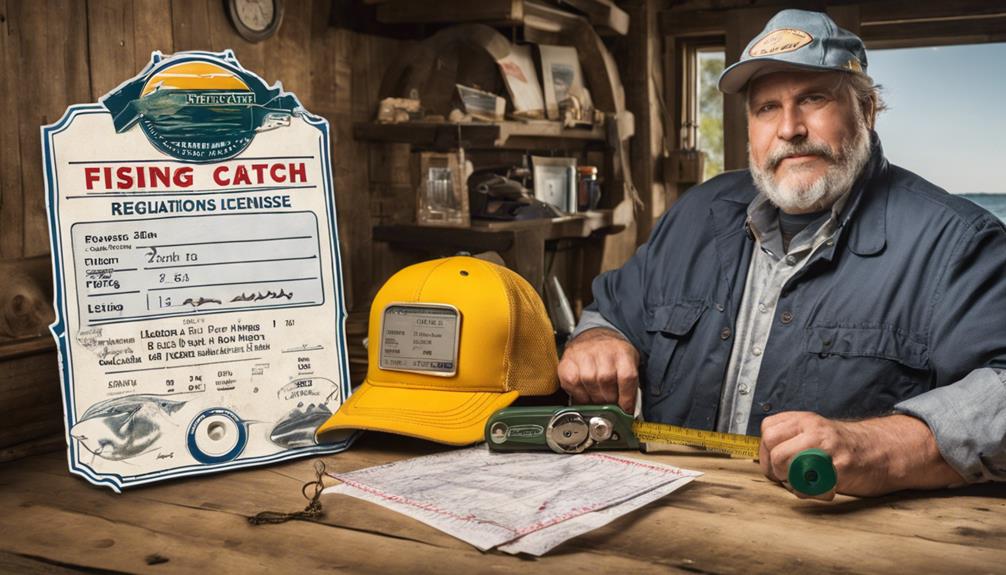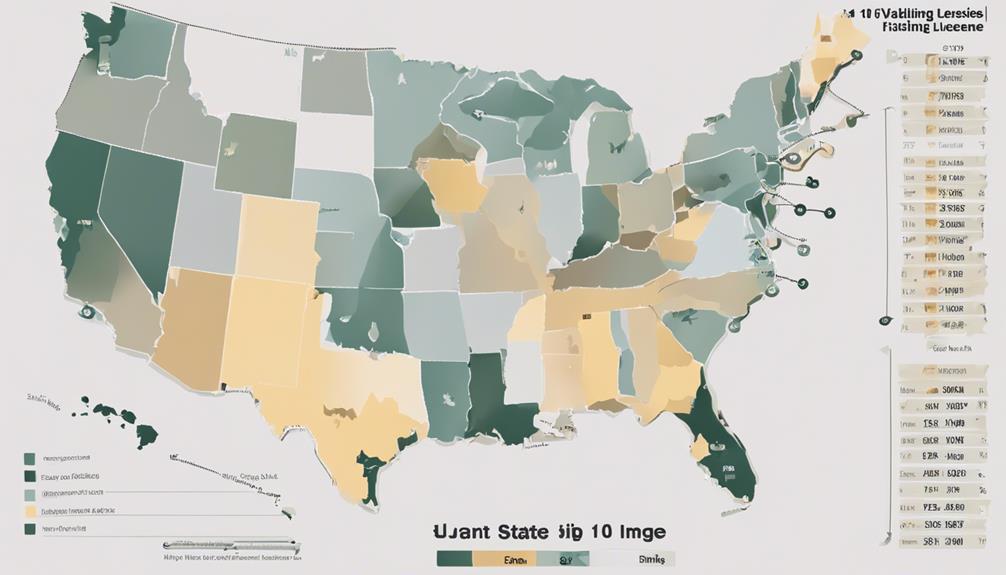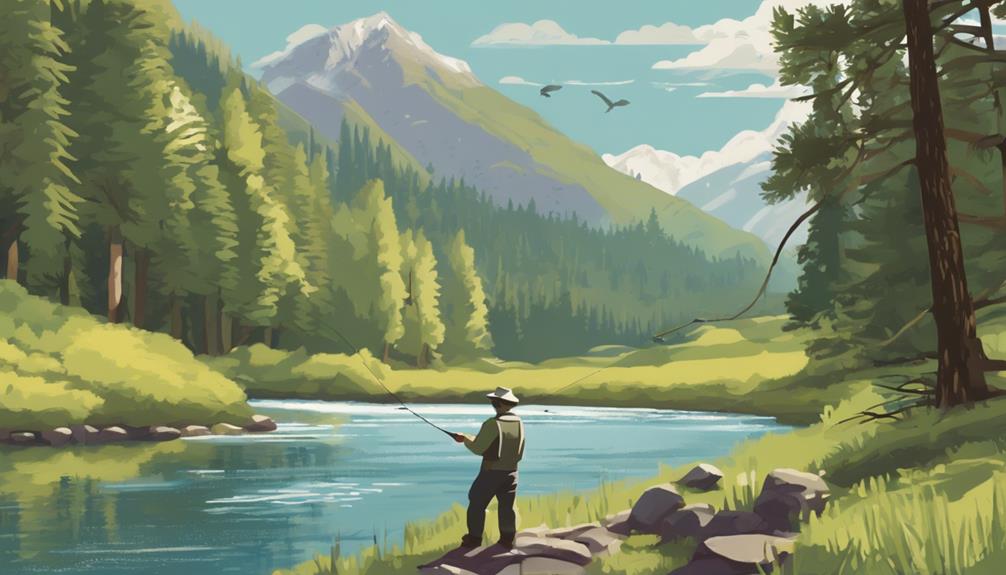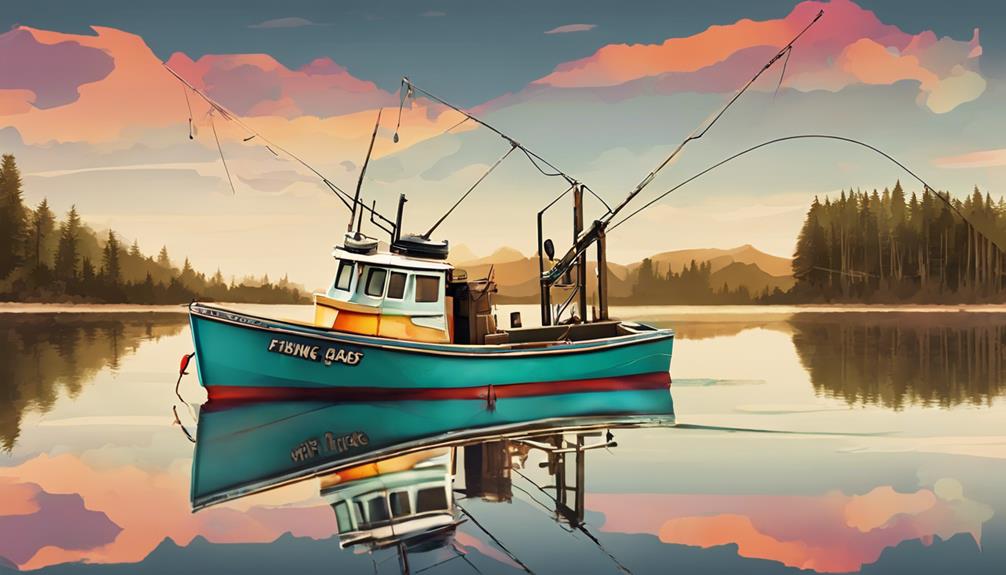Are you aware of the crucial factors to consider when it comes to sport fishing regulations and licenses?
Understanding the rules and requirements can significantly impact your fishing experience.
From license types to seasonal closures and catch reporting, there's a plethora of information to navigate.
Stay tuned as we uncover essential tips to ensure you're compliant and enjoy your time on the water to the fullest.
Understanding Fishing License Types
To ensure compliance with regulations, it's essential to understand the various types of fishing licenses available. When differentiating license types, you'll find that there are typically two main categories: freshwater fishing licenses and saltwater fishing licenses. Freshwater licenses are for fishing in inland waters like lakes and rivers, while saltwater licenses are for fishing in coastal waters and oceans.
Eligibility requirements for obtaining a fishing license vary by state but generally include age restrictions and residency specifications. Minors may need parental consent, and some states offer senior citizen discounts. Costs also differ based on factors such as duration and type of fishing. A freshwater license may be cheaper than a saltwater one, and annual licenses are often more cost-effective than daily permits.
When comparing costs, consider how often you plan to fish and in what locations. For those who fish frequently, an annual license could be more economical in the long run. The renewal process for fishing licenses is usually straightforward, with options for automatic renewal in some states.
For convenience, many states now offer an online application option for fishing licenses. This allows you to apply from the comfort of your home, saving time and eliminating the need to visit a physical office. Make sure to have all necessary documentation ready when applying online to streamline the process.
Checking State-Specific Regulations
Understanding the rules and regulations specific to your state is crucial when it comes to sport fishing. Each state has its own set of guidelines to ensure the sustainability of fish populations and the preservation of aquatic ecosystems.
When checking state-specific regulations, keep the following points in mind:
- Varied Regulations: Different states have different rules regarding fishing seasons, species that can be caught, and gear restrictions. Make sure you're familiar with the regulations in your area to avoid any fines or penalties.
- Special Fishing Zones: Some states have designated fishing hotspots that require special permits or have unique regulations. These areas are often conservation areas or sensitive habitats that need extra protection.
- Size and Bag Limits: State-specific regulations also cover size and bag limits for different fish species. Knowing these limits is essential to stay compliant and contribute to sustainable fishing practices.
- License Requirements: State laws dictate who needs a fishing license, the cost of the license, and where you can obtain one. Make sure you have the appropriate fishing license before heading out to your favorite fishing spot.
Knowing Bag and Size Limits
When fishing in your state, ensure you're aware of the specific bag and size limits set for different fish species. Bag limits refer to the maximum number of fish you're allowed to keep in a single day, while size limits dictate the minimum and sometimes maximum size a fish must be to legally keep it. These regulations are crucial for maintaining healthy fish populations and ecosystems.
To comply with size limits, always carry measuring devices when fishing. Measuring the fish accurately ensures you release undersized fish to support conservation efforts. Conservation efforts play a vital role in preserving fish populations for future generations. By following size limits, you contribute to the sustainability of fish stocks and help protect the overall aquatic environment.
Bag limits are designed to prevent overfishing and ensure that fish populations remain at sustainable levels. Exceeding bag limits can harm fish populations and disrupt the balance of the ecosystem. Responsible anglers adhere to these limits to support conservation efforts and promote ethical fishing practices. By understanding and following bag and size limits, you play a significant role in the conservation of fish species and their habitats.
Identifying Restricted Fishing Areas
Explore the designated restricted fishing areas in your state before heading out to ensure compliance with regulations and conservation efforts. Understanding where you can and can't fish is crucial in protecting the environment and maintaining sustainable fish populations.
Here are some key points to consider:
- Conservation zones: These areas are set aside to protect vulnerable species or habitats. Fishing in conservation zones can have severe consequences for the ecosystem, so it's essential to respect these boundaries.
- Restricted zones: Certain areas may be restricted due to ongoing research, restoration projects, or safety concerns. Be aware of these restrictions to avoid any legal issues and help with conservation efforts.
- Protected habitats: Habitats like coral reefs, seagrass beds, and mangrove forests are often off-limits to fishing to safeguard critical breeding grounds and nurseries for marine life. Stay informed about where these habitats are located to fish responsibly.
- No fishing zones: Some areas are designated as strictly no fishing zones to allow marine life to thrive undisturbed. These zones are essential for biodiversity and the overall health of the ecosystem, so be sure to steer clear of them.
Staying Up-to-Date on Seasonal Closures
Before venturing out for your next fishing trip, make sure to check for any seasonal closures in effect to comply with regulations and protect fish populations. Seasonal closures are often put in place to coincide with specific weather conditions or to protect fish populations during critical times such as spawning seasons. These closures may affect certain fishing spots, so it's crucial to stay informed.
Conservation efforts play a significant role in implementing seasonal closures. By restricting fishing activities during certain periods, authorities aim to minimize the environmental impact on fish populations. Overfishing during sensitive times can lead to a decline in fish stocks, affecting the overall ecosystem. Understanding and adhering to seasonal closures demonstrate your commitment to responsible angling practices and support conservation initiatives.
To stay up-to-date on seasonal closures, regularly check with local fishing authorities, visit their websites, or inquire at bait and tackle shops. These sources typically provide information on current closures and any updates due to changing conditions. It's essential to plan your fishing trips accordingly and respect these regulations to ensure the sustainability of fish populations for future generations.
Familiarizing With Catch Reporting Requirements
Understanding catch reporting requirements is essential for sport fishers to comply with regulations and contribute to sustainable fishing practices. To ensure you meet these requirements effectively, here are some key points to keep in mind:
- Reporting accuracy: It's crucial to provide precise information about your catches to regulatory authorities. This helps in monitoring fish populations and implementing conservation measures effectively.
- Compliance tracking: By accurately reporting your catches, you assist in tracking compliance with fishing regulations. This data aids in identifying any potential issues or trends that may require attention.
- Submission deadlines: Pay attention to submission deadlines for catch reports to avoid penalties or fines. Timely reporting is essential for effective fisheries management.
- Record-keeping: Maintain detailed records of your fishing activities, including the species caught, quantities, locations, and dates. These records not only help in reporting but also serve as a personal log of your fishing experiences.
Exploring Special Fishing Permits
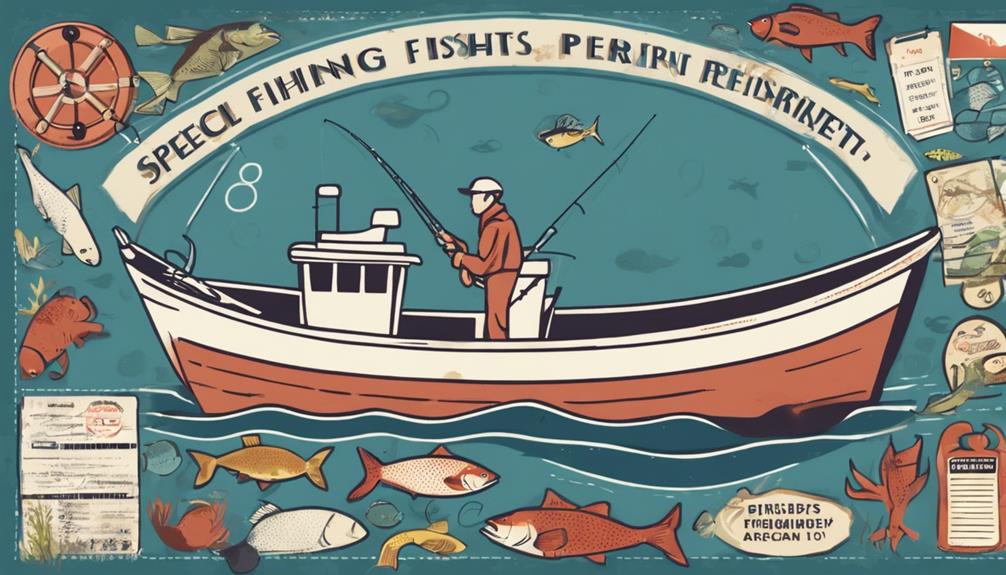
To further enhance your sport fishing experience and broaden your opportunities, consider acquiring special fishing permits tailored to specific locations or species. Special fishing permits allow you to access restricted areas or target certain exotic species while ensuring the conservation of endangered habitats. These permits often come with specific restrictions and require special applications to be filled out accurately.
When applying for special fishing permits, it's crucial to familiarize yourself with the permit restrictions. These restrictions could include limits on the number of fish you can catch, the size of the fish, or the specific locations where fishing is permitted. By adhering to these restrictions, you contribute to the sustainability of the ecosystem and help protect vulnerable species.
Special applications for permits may require additional information beyond what's needed for standard fishing licenses. You may need to provide details about the specific species you intend to target, the equipment you plan to use, and the duration of your fishing activities. By completing these applications thoroughly and honestly, you demonstrate your commitment to responsible fishing practices.
Exploring special fishing permits opens up new possibilities for your fishing adventures. Whether you're interested in catching exotic species or exploring protected habitats, acquiring the necessary permits shows respect for conservation efforts and allows you to enjoy unique fishing experiences.
Ensuring Compliance With Local Laws
Make sure you comply with local laws when engaging in sport fishing activities to avoid potential fines or penalties. It's essential to respect the regulations in place to protect fish populations and ensure a sustainable environment for future generations.
Here are some key points to consider:
- Know the Rules: Familiarize yourself with fishing regulations specific to the area you plan to fish in. Rules can vary significantly from one location to another, so it's crucial to stay informed.
- Respect Catch Limits: Adhere to catch limits to prevent overfishing and help maintain healthy fish stocks. Exceeding these limits can result in legal penalties and harm conservation efforts.
- Use Legal Bait and Equipment: Some areas have restrictions on the type of bait or equipment that can be used for fishing. Ensure you're using approved methods to avoid fines.
- Obtain the Necessary Permits: Make sure you have the required fishing licenses and permits before heading out. Fishing without the proper documentation can lead to legal consequences and hinder conservation efforts.
Frequently Asked Questions
Can I Fish in Multiple States With Just One Fishing License?
Yes, you can fish in multiple states with just one fishing license if there's license reciprocity between the states you plan to fish in. This allows you to cross fishing boundaries without needing separate licenses for each state.
Make sure to check the specific regulations and agreements in place to ensure you're compliant with the rules of each state you visit.
Enjoy your fishing adventures hassle-free with a single license!
Are There Any Special Regulations for Fishing in National Parks or Wildlife Refuges?
When fishing in national parks or wildlife refuges, you must follow special regulations to protect the environment. These rules are essential for fishing ethics and conservation efforts. Park policies focus on wildlife preservation, so make sure to respect them.
How Do I Properly Dispose of Unused Bait and Fishing Line to Protect the Environment?
To protect the environment, properly dispose of unused bait and fishing line.
Recycling initiatives help reduce the environmental impact of these waste materials. Take the extra step to dispose of them in designated recycling bins or waste collection sites.
By doing so, you can prevent harm to wildlife and keep waterways clean.
Avoid littering or leaving these items behind after your fishing trip to maintain the natural beauty of the area.
What Should I Do if I Accidentally Catch a Protected Species While Fishing?
If you accidentally catch a protected species while fishing, it's crucial to handle the situation carefully. Safely release the protected species back into the water, minimizing harm.
Take time to learn about conservation efforts and educate yourself on identifying protected species. By following guidelines and releasing them promptly, you contribute to the preservation of these vulnerable populations.
Are There Any Restrictions on Using Certain Types of Fishing Equipment, Such as Barbed Hooks or Lead Sinkers?
When fishing, you'll find restrictions on certain gear like barbed hooks or lead sinkers. These rules aim to protect the environment and specific species. Selective gear and catch and release practices are encouraged to minimize harm to wildlife.
Remember to check local regulations to ensure you're using permitted equipment. By following these guidelines, you can enjoy fishing responsibly while helping to conserve aquatic ecosystems.
Conclusion
Make sure you're informed and prepared when it comes to sport fishing regulations and licenses. By understanding the different types of licenses, checking state-specific regulations, and knowing bag and size limits, you can enjoy your fishing experience while staying compliant with the law.
Remember to stay updated on any seasonal closures, report your catches as required, and always comply with local laws to ensure a successful and legal fishing trip.
Happy fishing!
